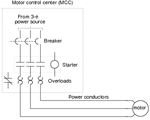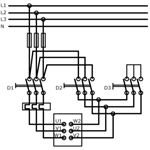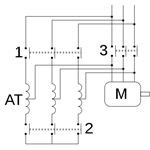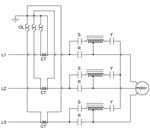Starting Methods for Induction Motors
Introduction
Most large induction motors are started directly on line, but when very large motors are started that way, they cause a disturbance of voltage on the supply lines due to large starting current surges. To limit the starting current surge, large induction motors are started at reduced voltage and then have full supply voltage reconnected when they run up to near rotated speed.
Two methods of reduced voltage starting are star delta starting and autotransformer stating. Contactors perform the switching action in the starter to connect and disconnect the power supply to the motor. If the current is above the rated current for the motor, the contactor will be tripped automatically to disconnect the motor from the supply.
A three phase supply is given to the stator of the three phase induction motor, and this in turn produces a magnetic field which revolves in space around the stator. As if the magnetic poles are being rotated, the speed of the rotating magnetic field is given by
N = 120 f /P
Starting Principle
The high starting current will produce severe a voltage drop and will affect the operation of other equipment. It is not desirable to start large motors direct on line (giving full voltage to the stator). Normally with motors beyond 5 HP, starters are provided. For reduction in the starting current, a lower voltage is applied to the stator, especially for the squirrel cage induction motors. Full voltage is only applied when the motor picks up speed.
Starting methods of Induction motor include:
- Direct –On– line (DOL) starters for less than 10 Kw motors.
- Star–Delta starters for large motors. The stator winding is initially connected in a star configuration and later on changed over to a Delta connection, when the motor reaches rated speed.
- Auto transformer.
1. Direct On Line Starter
- It is simple and cheap starter for a 3-phase induction motor.
- The contacts close against spring action.
- This method is normally limited to smaller cage induction motors, because starting current can be as high as eight times the full load current of the motor. Use of a double –cage rotor requires lower staring current( approximately four times) and use of quick acting A.V.R enables motors of 75 Kw and above to be started direct on line.
- An isolator is required to isolate the starter from the supply for maintenance.
- Protection must be provided for the motor. Some of the safety protections are over-current protection, under-voltage protection, short circuit protection, etc. Control circuit voltage is sometimes stepped down through an autotransformer.
2. Star-Delta Starter
- A three phase motor will give three times the power output when the stator windings are connected in delta than if connected in star, but will take 1/3 of the current from the supply when connected in star than when connected in delta. The starting torque developed in star is ½ that when starting in delta.
- A two-position switch (manual or automatic) is provided through a timing relay.
- Starting in star reduces the starting current.
- When the motor has accelerated up to speed and the current is reduced to its normal value, the starter is moved to run position with the windings now connected in delta.
- More complicated than the DOL starter, a motor with a star-delta starter may not produce sufficient torque to start against full load, so output is reduced in the start position. The motors are thus normally started under a light load condition.
- Switching causes a transient current which may have peak values in excess of those with DOL.
3. Auto Transformer Motor Starting
- Operated by a two position switch i.e. manually / automatically using a timer to change over from start to run position.
- In starting position supply is connected to stator windings through an auto-transformer which reduces applied voltage to 50, 60, and 70% of normal value depending on tapping used.
- Reduced voltage reduces current in motor windings with 50% tapping used motor current is halved and supply current will be half of the motor current. Thus starting current taken from supply will only be 25% of the taken by DOL starter.
- For an induction motor, torque T is developed by V2, thus on 50% tapping, torque at starting is only (0.5V)2 of the obtained by DOL starting. Hence 25% torque is produced.
- Starters used in lager industries, it is larger in size and expensive.
- Switching from start to run positions causing transient current, which can be greater in value than those obtained by DOL starting.
- This starter is used with a wound rotor induction motor. It uses an external resistance/phase in the rotor circuit so that rotor will develop a high value of torque.
- High torque is produced at low speeds, when the external resistance is at its higher value.
- At start, supply power is connected to stator through a three pole contactor and, at a same time, an external rotor resistance is added.
- The high resistance limits staring current and allows the motor to start safely against high load.
- Resistors are normally of the wire-wound type, connected through brushes and slip rings to each rotor phase. They are tapped with points brought out to fixed contactors.
- As the motor starts, the external rotor resistance is gradually cut out of circuit ; the handle or starter is turned and moves the three contacts simultaneously from one fixed contact to the next.
- The three moving contacts are interconnected to form a start point for the resistors.
- To ensure that the motor cannot be started until all rotor resistance is in circuit, an interlock is fitted which prevents the contactors from being closed until this condition is fulfilled.
Download module here- Source








0 Response to "Starting Methods for Induction Motors"
Post a Comment